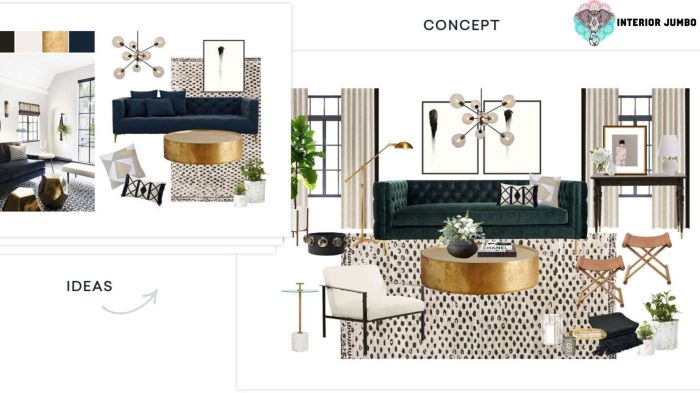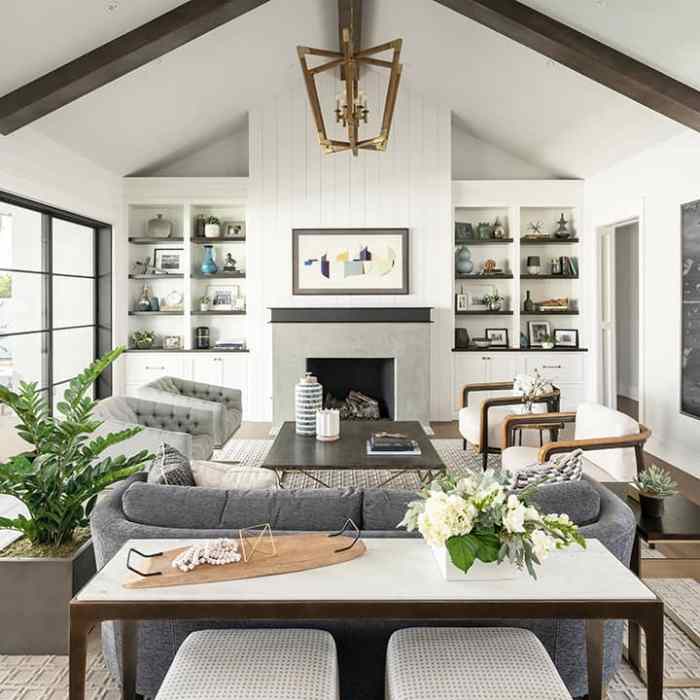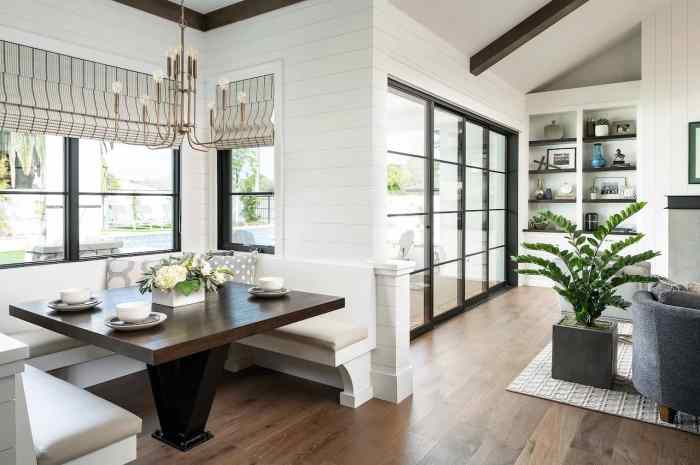Exploring Innovative Interior Design Concepts
Embark on a journey through the realm of interior design concepts, where creativity meets functionality in the most captivating ways. From the fundamental principles to the intricate elements, this topic promises to unravel a world of inspiration and aesthetics.
Delve deeper into the essence of interior design concepts and discover the secrets behind creating spaces that truly resonate with individual style and personality.
Fundamental Principles of Interior Design Concepts

Space planning is a crucial aspect of interior design concepts as it involves arranging furniture, decor, and other elements in a space to optimize functionality and flow. Proper space planning ensures that the space is used efficiently and effectively, creating a harmonious balance between aesthetics and practicality.
Importance of Space Planning
Space planning is essential in interior design as it determines how people interact with a space, whether it be a home, office, or commercial environment. By carefully considering the layout and flow of a space, interior designers can create environments that are not only visually appealing but also functional and comfortable for the occupants.
- Space planning allows for the efficient use of space, maximizing the potential of a room or building.
- It helps create designated areas for specific functions, such as workspaces, relaxation areas, and dining spaces.
- Proper space planning can improve traffic flow within a space, ensuring that there are clear pathways and no obstructions.
Color Theory in Interior Design Concepts
Color theory plays a significant role in interior design concepts as different colors can evoke various emotions and set the tone for a space. Understanding how colors interact with each other and the impact they have on mood and perception is crucial for creating cohesive and visually appealing interiors.
- Warm colors like red, orange, and yellow can create a sense of energy and warmth in a space.
- Cool colors such as blue, green, and purple are calming and can help create a serene atmosphere.
- Neutral colors like white, beige, and gray are versatile and can be used as a backdrop to highlight other elements in a room.
Role of Lighting in Enhancing Interior Design Concepts
Lighting is an essential element in interior design concepts as it can influence the mood, ambiance, and functionality of a space. Proper lighting design can highlight architectural features, create focal points, and enhance the overall aesthetic of a room.
- Natural light can make a space feel open and airy, enhancing the overall sense of space.
- Task lighting is important for specific activities such as reading, cooking, or working, providing adequate illumination for the task at hand.
- Ambient lighting sets the overall mood of a space, creating a welcoming and inviting atmosphere.
Elements of Interior Design Concepts

Texture and pattern play a crucial role in interior design concepts as they add depth, visual interest, and personality to a space. The careful selection and combination of different textures and patterns can elevate the overall aesthetic and create a harmonious balance within the design.
Significance of Texture and Pattern
- Texture adds tactile qualities to a space, creating a sense of warmth and dimension.
- Patterns can be used to create visual impact, add movement, and define the style of a room.
- The careful layering of textures and patterns can enhance the overall design, making it more visually appealing and inviting.
Use of Furniture and Decor
- Furniture serves both a functional and decorative purpose in interior design, helping to define the layout and flow of a space.
- Decor items such as rugs, curtains, and art pieces can be used to add personality and style to a room.
- The careful selection and placement of furniture and decor items can greatly impact the overall look and feel of a space.
Impact of Different Styles
- Modern interior design focuses on clean lines, minimalism, and the use of sleek materials like glass and metal.
- Minimalist design emphasizes simplicity, functionality, and the use of neutral colors and natural materials.
- Eclectic style combines elements from different design styles, creating a unique and personalized look.
Spatial Organization in Interior Design

Spatial organization in interior design refers to the arrangement of spaces within a room or building to create a functional and visually appealing environment. One key aspect of spatial organization is the concept of flow and circulation.
Flow and Circulation
Flow and circulation in interior design refer to how people move through and interact with a space. A well-designed space should have a logical flow that allows for easy movement and access to different areas. This can be achieved through thoughtful placement of furniture, creating clear pathways, and considering the use of natural light to guide movement.
Zoning in Interior Design
Zoning is the practice of dividing a space into different functional areas based on their intended use. This can help to define specific areas for activities such as dining, lounging, or working. By zoning a space, designers can create a sense of order and organization while also enhancing the overall design concept.
For example, a living room may be zoned into a seating area, a reading nook, and an entertainment zone.
Balancing Open and Enclosed Spaces
Balancing open and enclosed spaces is crucial in interior design to create a sense of harmony and variety. Open spaces can make a room feel more spacious and airy, while enclosed spaces provide privacy and intimacy. By finding the right balance between these two types of spaces, designers can create a dynamic and engaging environment that meets the needs of the occupants.
Sustainability in Interior Design Concepts
When it comes to interior design concepts, sustainability plays a crucial role in creating spaces that are not only visually appealing but also environmentally friendly and socially responsible. Incorporating sustainable practices and materials in interior design is essential for reducing the negative impact on the environment and promoting healthier living spaces.
Role of Sustainable Materials
Using sustainable materials in modern interior design concepts is imperative for minimizing the environmental footprint of a project. These materials are sourced ethically, produced with minimal waste and energy consumption, and are often recyclable or biodegradable. By opting for materials such as reclaimed wood, bamboo, cork, or recycled glass, interior designers can contribute to a more sustainable future while creating unique and stylish spaces.
Significance of Energy-Efficient Design Principles
Energy-efficient design principles are crucial in interior design concepts as they help reduce energy consumption, lower utility costs, and minimize the carbon footprint of a space. By incorporating features such as proper insulation, energy-efficient lighting, and smart home technology, interior designers can create spaces that are not only environmentally friendly but also cost-effective and comfortable for the occupants.
Impact of Eco-Friendly Practices
Eco-friendly practices in interior design concepts have a positive impact on both the environment and the well-being of the occupants. By using non-toxic paints, low VOC materials, and sustainable furniture, designers can create spaces that promote better indoor air quality and overall health.
Additionally, incorporating biophilic design elements such as indoor plants and natural light can enhance the connection to nature and improve the mental and emotional well-being of the occupants.
Conclusive Thoughts
As we reach the end of this discussion on interior design concepts, one thing remains clear - the power of design to transform spaces and evoke emotions is truly unparalleled. Let your imagination soar and your creativity flourish as you apply these concepts to your own living spaces.
Questions and Answers
How does lighting influence interior design concepts?
Lighting plays a crucial role in setting the mood and highlighting key elements within a space, ultimately shaping the overall ambiance of the design.
What is the significance of texture and pattern in interior design concepts?
Texture and pattern add depth and visual interest to a space, creating a dynamic and inviting environment that reflects personal style.
How can zoning be utilized to enhance interior design concepts?
Zoning helps define different areas within a space for specific functions, optimizing both the visual appeal and practicality of the design.